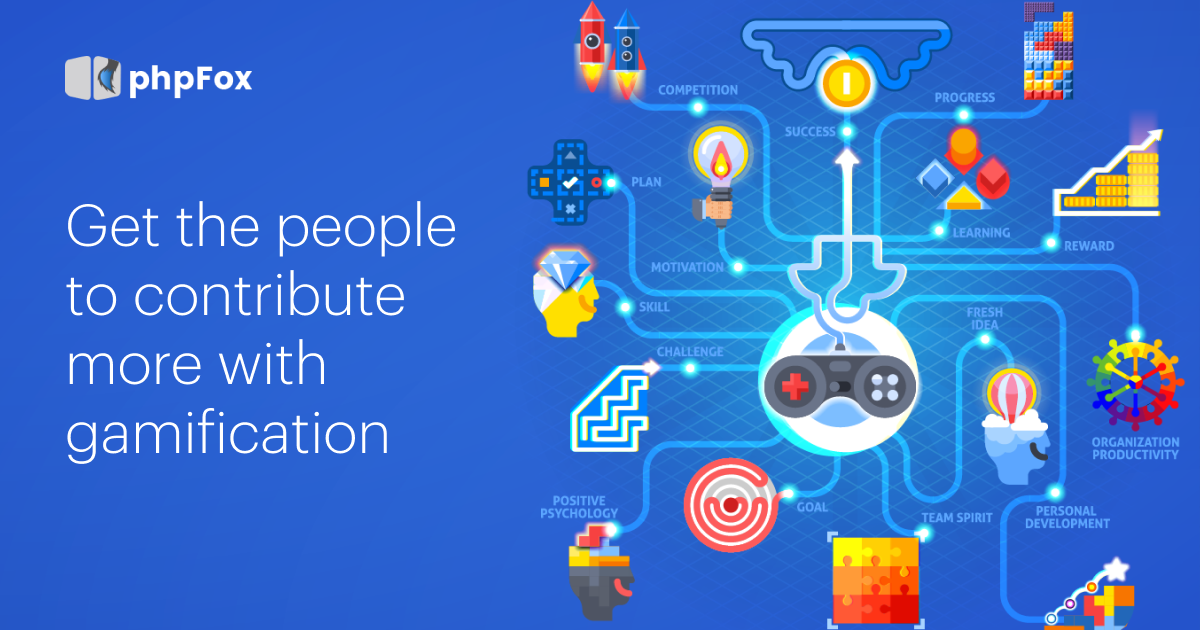
Gamification is to use elements of game design in non-game applications to make them more enjoyable and engaging. And it’s increasing – according to M2 research[1], the gamification market would generate direct spending of 2.8 billion dollars by 2016.
RELATED: 5 quick solutions for spam protection on phpFox
In This Article:
- What Exactly Is Gamification?
- How Gamification Works
- Gamification Principles
- How Does Gamification Increase Engagement?
Gamification – a New Way to Boost User Engagement
What Exactly Is Gamification?
Gamification is the application of game designers’ tactics and approaches to circumstances other than games in order to persuade others to regard these situations as if they were games. These might include elements like enjoyment, rules, competitiveness, points, and so forth, and then applying them to non-game situations.
There are several examples of gamification, arguably the most well-known being airline frequent flyer rewards schemes. The degree of engagement, impact, brand loyalty, time spent on an activity, and the game’s capacity to go viral are all significant measurable success indicators from gamification.
Gamification occurs whenever game-like characteristics or components of game design are brought into non-game situations. In other words, real-world tasks are turned game-like to inspire individuals to attain their objectives. Frequent flyer programs, loyalty rewards points, and frequent shopper points are all instances of how gamification is used in everyday life. This gets them to keep “playing” and racking up the points to achieve the goals.
How Gamification Works
Gamification makes use of people’s inherent impulses toward competitiveness, success, teamwork, and compassion. Tools used in game design, such as rewarding users for successes, “leveling up,” and earning badges, are transferred into the real world to help inspire people to achieve their objectives or enhance performance.
Smart marketers utilize it to increase consumer engagement and influence consumer behavior. To do this, customers should be rewarded with virtual goods (such as points) for certain behaviors (e.g., purchasing something, joining up, using the product, filling out their profile), and those virtual objects should grant access to special privileges and incentives, such as levels or prizes.
Gamification Principles
Prof. B.J. Fogg, an experimental psychologist at Stanford University[2], created a model for behavior modification. It states that for a behavior to occur, three factors must converge at the same time: motivation, ability, and trigger. The essential element is that all three factors must converge together.
The structure is all on timing – if all of the components don’t fire simultaneously, the player will lose interest or grow upset. Here are some gamification principles to consider when designing your website and applications.
- Rewards. A reward is something you receive and are pleased with, and the essential component is the bit about feeling good. Consumers should be rewarded with virtual goods (e.g., points) for particular behavior (e.g., purchase, form completion). Those virtual things should provide access to exclusive privileges and incentives, such as levels or prizes.
- Loss Aversion[3]. Most individuals would rather avoid losses than make gains. One approach to get started is to give folks something they can lose straight away (unless they keep playing).
- Status, competition, and reputation. Most people innately desire a greater status, and not only to keep up with others. This is why leaderboards are beneficial. Making accomplishments social also motivates people to constantly one-up one another and stay motivated to attain certain goals.
- Feedback. Feedback informs users that their desired action has been registered and displays the results of that action. Seeing points increase as activities are performed, a clear and immediate reward system. It’s also a clear indicator that the user is coming closer to achieving their objective. Achieving minor goals on a regular basis in order to achieve a greater goal is typically what makes games addicting.
How Does Gamification Increase Engagement?
To summarize the psychology underlying it, game dynamics employ positive feedback (points, badges, status, progression, and so on) to motivate users. Following that, they improve users’ perceived ability by making tough activities/challenges easier to do, either via practice or by decreasing the activation threshold of the desired behavior.
When motivated users have the most excess in their abilities, game dynamics place triggers in their path. That is, triggers that prompt the user to act are intended to bring together motivation, ability, and trigger all at the same time.
All of this adds up to a powerful motivator of user behavior.
With phpFox built-in features, you can easily apply gamification to your social network to improve the overall experience of the user and get them HOOKED. phpFox has already developed methods to achieve points, the base to build gamification for each social network. For instance, building an award module for users based on their achievement points.
Just ONE click away to get your own Gamified Online Social Network.
UP NEXT:
Reference List:
[1] What is Gamification? – Wanda Meloni – M2 research. Retrieved from:
https://www.slideshare.net/gzicherm/wanda-amification-summit-presentation-m2-research-final
[2] Fogg Behavior Model – Prof. B.J. Fogg, Stanford University. Retrieved from:
[3] Loss aversion – Wikipedia. Retrieved from: